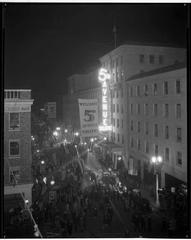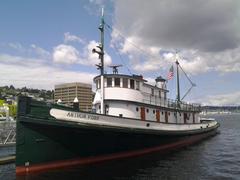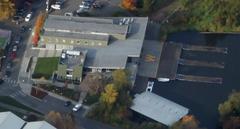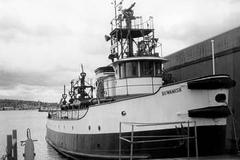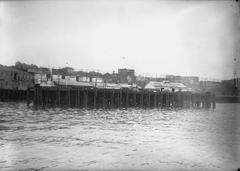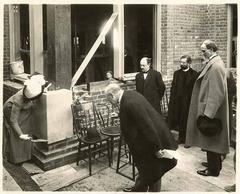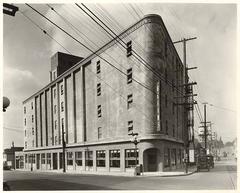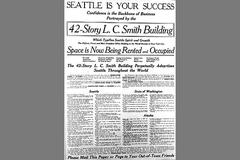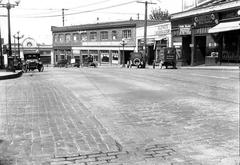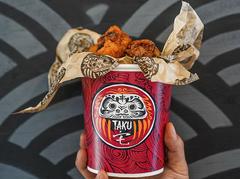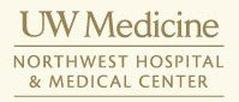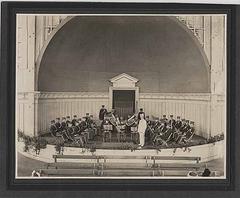7th and Jackson Seattle Visiting Hours, Tickets, and Historical Sites Guide
Date: 03/07/2025
Introduction
Located at the intersection of 7th Avenue South and South Jackson Street, 7th & Jackson serves as a vibrant crossroads within Seattle’s Chinatown-International District (CID). This area is a living testament to the city’s layered Indigenous roots, multicultural immigration history, and its enduring legacy as a hub for African American jazz, community activism, and resilient cultural exchange. From its earliest days as Coast Salish land through waves of immigration and urban transformation, 7th & Jackson remains a focal point for historical exploration, culinary adventure, and cultural celebration (Wikipedia: History of Seattle).
This comprehensive guide covers everything you need to know for a visit: from historical context and key attractions to practical information on visiting hours, ticketing, transit, accessibility, and tips for making the most of your time in this iconic Seattle neighborhood.
Table of Contents
- Indigenous Roots and Early Settlement
- Urban Development and the Jackson Regrade
- Multicultural Confluence: The Birth of a Diverse District
- The Jackson Street Jazz Era (1930s–1950s)
- Social Challenges and Resilience
- Decline and Transformation (1960s–1990s)
- Contemporary Recognition and Preservation
- Visitor Information: Hours, Tickets, and Accessibility
- Living History: Arts, Cuisine, and Community Today
- Neighborhood Atmosphere and Layout
- Cultural and Historical Significance
- Key Attractions and Visiting Information
- Events and Festivals
- Transportation and Accessibility
- Safety and Practical Tips
- Visitor Services and Amenities
- Nearby Attractions
- Local Etiquette and Cultural Sensitivity
- Best Times to Visit
- Frequently Asked Questions (FAQ)
- Local Tips for a Memorable Visit
- Emergency Contacts
- Summary and Key Visitor Tips
- References and Further Reading
Indigenous Roots and Early Settlement
The land encompassing 7th & Jackson has been home to the Coast Salish peoples, notably the Duwamish and Suquamish tribes, for thousands of years. Archaeological evidence indicates continuous habitation for over 4,000 years, with significant Indigenous villages near today’s King Street Station (Wikipedia: History of Seattle). The area’s proximity to Elliott Bay and the Duwamish River fostered a natural center for trade and gathering long before European settlers arrived.
European exploration began in 1792, and by the 1850s, Seattle’s foundation accelerated development at 7th & Jackson as new infrastructure and businesses took root (Wikipedia: History of Seattle).
Urban Development and the Jackson Regrade
Seattle’s hilly landscape necessitated major engineering projects like the Jackson Regrade in the early 20th century. This transformation leveled steep terrain, making way for new roads, railways, and buildings. The regrade catalyzed the growth of the CID and positioned 7th & Jackson as a bustling urban hub (Wikipedia: History of Seattle).
Multicultural Confluence: The Birth of a Diverse District
By the early 1900s, 7th & Jackson had become the heart of Seattle’s Chinatown–International District. The intersection connected Chinatown, Japantown, Filipino Town, and the historically Black Central District, making it a rare gathering place across racial and cultural lines—even during periods of segregation (Front Porch Seattle). The CID flourished as immigrants established businesses, social clubs, and cultural institutions—an enduring legacy symbolized today by the Chinatown Gate (Visit Seattle).
The Jackson Street Jazz Era (1930s–1950s)
From the 1930s through the 1950s, 7th & Jackson anchored Seattle’s jazz scene, forming the legendary Jackson Street Jazz District. Clubs like the Black & Tan, New Chinatown, and Ebony Café welcomed musicians and audiences of all backgrounds, nurturing talents such as Ray Charles, Quincy Jones, and Ernestine Anderson (Front Porch Seattle; KNKX Jazz). The district was a rare integrated space in segregated America, making it a beacon for artistic innovation and cultural resilience.
Social Challenges and Resilience
Despite its vibrancy, the area faced segregation, redlining, and the forced internment of Japanese Americans during World War II, which devastated Japantown. Yet, the neighborhood’s multicultural fabric persisted, revitalized by returning residents and new immigrants (Wikipedia: History of Seattle; Front Porch Seattle).
Decline and Transformation (1960s–1990s)
The jazz era faded in the 1960s due to changes in nightlife and liquor laws, ending union segregation, and the rise of new music genres (KNKX Jazz). Urban renewal projects and freeway construction displaced many residents and businesses, but community activism and preservation efforts helped sustain the district’s historic character (Visit Seattle).
Contemporary Recognition and Preservation
Today, 7th & Jackson is honored through city signage, public art, and community initiatives. The Jackson Street Jazz Trail Committee offers a walking tour with historical stops, and the Washington State Black Legacy Institute features a dedicated Jackson Street Jazz exhibit (Front Porch Seattle; Jackson Street Jazz Trail). Signal box art and murals celebrate female jazz musicians and other cultural icons.
Visitor Information: Hours, Tickets, and Accessibility
- General Hours: The neighborhood and intersection are accessible 24/7. Most attractions are open from 9 AM to 7 PM; check specific venues for details.
- Tickets: Street-level exploration is free. Museums and guided tours may require admission (typically $10–$25). Advance booking is recommended for tours and special events.
- Accessibility: The area is pedestrian-friendly with curb cuts and accessible transit. Some historic buildings may have limited wheelchair access.
- Getting There: Served by Link light rail (International District/Chinatown Station), First Hill Streetcar, and multiple bus routes.
Living History: Arts, Cuisine, and Community Today
The neighborhood’s living culture is reflected in immersive theater (e.g., Café Nordo’s historic productions), live music, and a thriving culinary landscape (Seattle Globalist; Café Nordo). Annual events like Lunar New Year and Dragon Fest celebrate the area’s ongoing multicultural vibrancy (Events12: Seattle July).
Neighborhood Atmosphere and Layout
7th & Jackson is the CID’s heart, defined by historic architecture, bustling storefronts, and public art—like the iconic dragon lampposts (Wikipedia). The area is walkable, with broad sidewalks, crosswalks, and a blend of old and new structures displaying traditional Asian designs.
Cultural and Historical Significance
This intersection symbolizes the convergence of Seattle’s Asian American communities, shaped by immigration waves, urban renewal, and resilience after the 1889 Great Seattle Fire and the Jackson Regrade (PreserveWA). The district is listed on the National Register of Historic Places and is part of Seattle’s International Special Review District (NPS).
Key Attractions and Visiting Information
- Wing Luke Museum of the Asian Pacific American Experience
- 719 S King St.
- Hours: Tues–Sun, 10 AM–5 PM; closed Mondays/holidays
- Tickets: $16 adults; $12 seniors; $10 students; free for children under 6 (Wing Luke Museum official website)
- Tours: Regular guided walking tours—advance booking recommended
- Kong Yick Buildings: Historic 1910 structures housing businesses and the museum.
- Public Art: Dragon lampposts, murals, and installations by local artists.
- Dining & Shopping: Jade Garden (dim sum), Uwajimaya (Asian supermarket), Tai Tung (Seattle’s oldest Chinese restaurant), Hood Famous Café + Bar (Filipino-inspired).
Events and Festivals
- Lunar New Year: Lion dances, martial arts, food stalls (winter)
- Dragon Fest: Summer cultural festival
- Night Market: Seasonal evening market with music and crafts
Find dates and details on the PreserveWA website.
Transportation and Accessibility
- Light Rail: International District/Chinatown Station (2 blocks west)
- Streetcar: First Hill Streetcar stops at 7th Ave S & S Jackson St
- Bus: Multiple Metro routes along Jackson Street
- Parking: Limited street parking and nearby paid lots
Sidewalks and crossings are generally wheelchair accessible. The Wing Luke Museum is fully accessible, but check individual businesses for details.
Safety and Practical Tips
- The CID is safe during the day; exercise standard urban caution at night, especially near King Street Station (Travel Lemming).
- Stay on main streets after dark.
- Use public transit or rideshare for late-night travel.
- Seattle weather is changeable—bring layers and rain gear.
Visitor Services and Amenities
- Restrooms: At transit stations and major businesses like Uwajimaya.
- Tourist Info: Maps and guides at the Wing Luke Museum.
- Wi-Fi: Available in cafes and the local library.
Nearby Attractions
- Pioneer Square: Historic neighborhood
- Seattle Pinball Museum (The Crazy Tourist)
- Union Station and King Street Station: Historic train stations
- Seattle Art Museum: Easily reached via light rail
Local Etiquette and Cultural Sensitivity
- Support local and family-owned businesses.
- Ask permission before photographing people or private spaces.
- Respect cultural customs and dispose of trash responsibly.
Best Times to Visit
The area is lively year-round, with peak activity during festivals and weekends. Summer brings the best weather; weekdays and mornings are quieter.
Frequently Asked Questions (FAQ)
Q: What are the visiting hours for 7th & Jackson?
A: The intersection and public art are accessible daily; most attractions operate 9 AM–7 PM. Check individual sites for specific hours.
Q: Are tickets required?
A: Public art and street exploration are free; museums and tours may require tickets.
Q: Is the area accessible by public transit?
A: Yes, via Link light rail, streetcar, and multiple bus routes.
Q: Are guided tours available?
A: Yes, through the Wing Luke Museum and other operators. Advance booking is advised.
Local Tips for a Memorable Visit
- Explore side alleys for murals and hidden shops (Travel Lemming).
- Try independent coffee shops for an authentic Seattle experience (The Awayist).
- Use public transit and bring a reusable water bottle (Visit Seattle City).
- Stay alert at crosswalks—S Jackson St is busy (Seattle DOT Vision Zero).
- Check Seattle DOT for construction updates.
Emergency Contacts
- Non-Emergency Police: (206) 625-5011
- Medical Emergencies: 911
- Seattle Visitor Center: (206) 461-5888 (Visit Seattle)
- Transportation Inquiries: (206) 684-7623 (Seattle DOT)
Summary and Key Visitor Tips
7th & Jackson encapsulates Seattle’s rich Indigenous, immigrant, and jazz heritage. Today, it offers a dynamic blend of history, arts, and cuisine—best explored on foot or via public transit. Attend festivals, visit museums like the Wing Luke Museum and the Washington State Black Legacy Institute, and support local businesses to experience the neighborhood’s unique spirit and resilience (Wikipedia: History of Seattle; Front Porch Seattle; Visit Seattle; Hoodline).
For updates, events, and immersive self-guided tours, download the Audiala app and follow local organizations on social media (Jackson Street Jazz Trail; Café Nordo).
References and Further Reading
- History of Seattle, Wikipedia
- A Walk Through the Historic Jackson Street Jazz District, Front Porch Seattle
- New Immersive Tour Seattle Chinatown-International Asian Black Central District Jackson Street Jazz Trail History American Culture Music, KNKX Jazz
- Seattle Chinatown-International District, Treksplorer
- Top 25 Attractions in Seattle, Visit Seattle
- Seattle Celebrates Jazz Legacy with Jackson Street Walking Tour and New Exhibits, Hoodline
- Seattle Chinatown Historic District, National Park Service
- 7th and Jackson revisits a Seattle crossroads of history, place and culture, Seattle Globalist
- 7th and Jackson, Café Nordo
- Seattle Chinatown International District Preservation and Development Authority, PreserveWA
